Analysis of Information Communication Technology: Key Concepts
VerifiedAdded on 2023/06/11
|15
|4067
|112
Homework Assignment
AI Summary
This assignment delves into several key topics in Information Communication Technology (ICT). It begins with an analysis of the Meltdown and Spectre CPU exploits, detailing how these exploits leverage CPU features to extract sensitive data. The assignment then examines VisiCorp Visi On, a pioneering GUI-based operating system, discussing its features, limitations, and impact. Further, it explores the connectivity challenges in the Internet of Things (IoT), comparing LPWAN and cellular technologies. The assignment also provides an overview of the Session Initiation Protocol (SIP) and its role in VoIP communications. Blockchain technology and its application in cryptocurrency are also discussed, along with the potential effects of net neutrality debates on website accessibility and internet usage. The document provides an overview of each technology, its functions, and potential impacts.
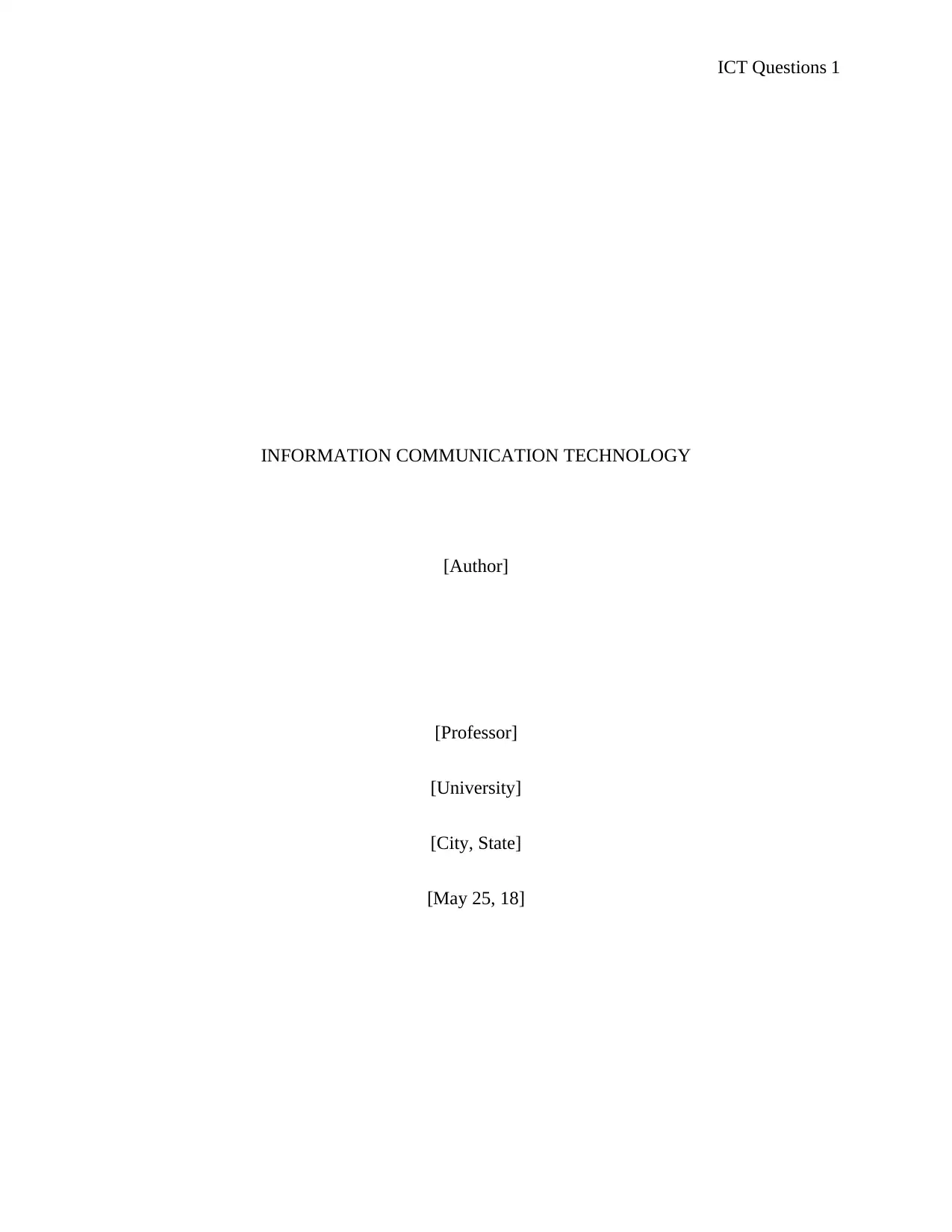
ICT Questions 1
INFORMATION COMMUNICATION TECHNOLOGY
[Author]
[Professor]
[University]
[City, State]
[May 25, 18]
INFORMATION COMMUNICATION TECHNOLOGY
[Author]
[Professor]
[University]
[City, State]
[May 25, 18]
Paraphrase This Document
Need a fresh take? Get an instant paraphrase of this document with our AI Paraphraser
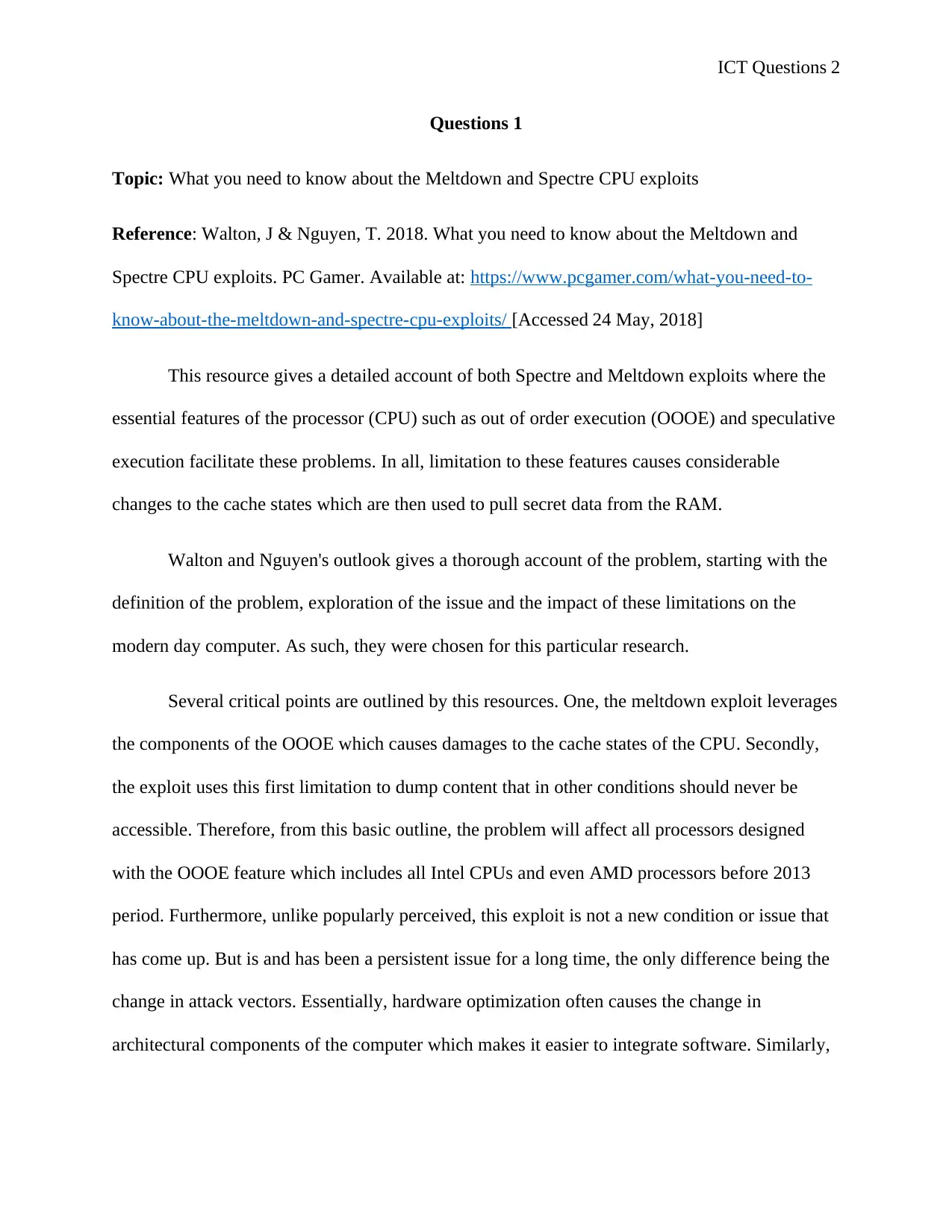
ICT Questions 2
Questions 1
Topic: What you need to know about the Meltdown and Spectre CPU exploits
Reference: Walton, J & Nguyen, T. 2018. What you need to know about the Meltdown and
Spectre CPU exploits. PC Gamer. Available at: https://www.pcgamer.com/what-you-need-to-
know-about-the-meltdown-and-spectre-cpu-exploits/ [Accessed 24 May, 2018]
This resource gives a detailed account of both Spectre and Meltdown exploits where the
essential features of the processor (CPU) such as out of order execution (OOOE) and speculative
execution facilitate these problems. In all, limitation to these features causes considerable
changes to the cache states which are then used to pull secret data from the RAM.
Walton and Nguyen's outlook gives a thorough account of the problem, starting with the
definition of the problem, exploration of the issue and the impact of these limitations on the
modern day computer. As such, they were chosen for this particular research.
Several critical points are outlined by this resources. One, the meltdown exploit leverages
the components of the OOOE which causes damages to the cache states of the CPU. Secondly,
the exploit uses this first limitation to dump content that in other conditions should never be
accessible. Therefore, from this basic outline, the problem will affect all processors designed
with the OOOE feature which includes all Intel CPUs and even AMD processors before 2013
period. Furthermore, unlike popularly perceived, this exploit is not a new condition or issue that
has come up. But is and has been a persistent issue for a long time, the only difference being the
change in attack vectors. Essentially, hardware optimization often causes the change in
architectural components of the computer which makes it easier to integrate software. Similarly,
Questions 1
Topic: What you need to know about the Meltdown and Spectre CPU exploits
Reference: Walton, J & Nguyen, T. 2018. What you need to know about the Meltdown and
Spectre CPU exploits. PC Gamer. Available at: https://www.pcgamer.com/what-you-need-to-
know-about-the-meltdown-and-spectre-cpu-exploits/ [Accessed 24 May, 2018]
This resource gives a detailed account of both Spectre and Meltdown exploits where the
essential features of the processor (CPU) such as out of order execution (OOOE) and speculative
execution facilitate these problems. In all, limitation to these features causes considerable
changes to the cache states which are then used to pull secret data from the RAM.
Walton and Nguyen's outlook gives a thorough account of the problem, starting with the
definition of the problem, exploration of the issue and the impact of these limitations on the
modern day computer. As such, they were chosen for this particular research.
Several critical points are outlined by this resources. One, the meltdown exploit leverages
the components of the OOOE which causes damages to the cache states of the CPU. Secondly,
the exploit uses this first limitation to dump content that in other conditions should never be
accessible. Therefore, from this basic outline, the problem will affect all processors designed
with the OOOE feature which includes all Intel CPUs and even AMD processors before 2013
period. Furthermore, unlike popularly perceived, this exploit is not a new condition or issue that
has come up. But is and has been a persistent issue for a long time, the only difference being the
change in attack vectors. Essentially, hardware optimization often causes the change in
architectural components of the computer which makes it easier to integrate software. Similarly,
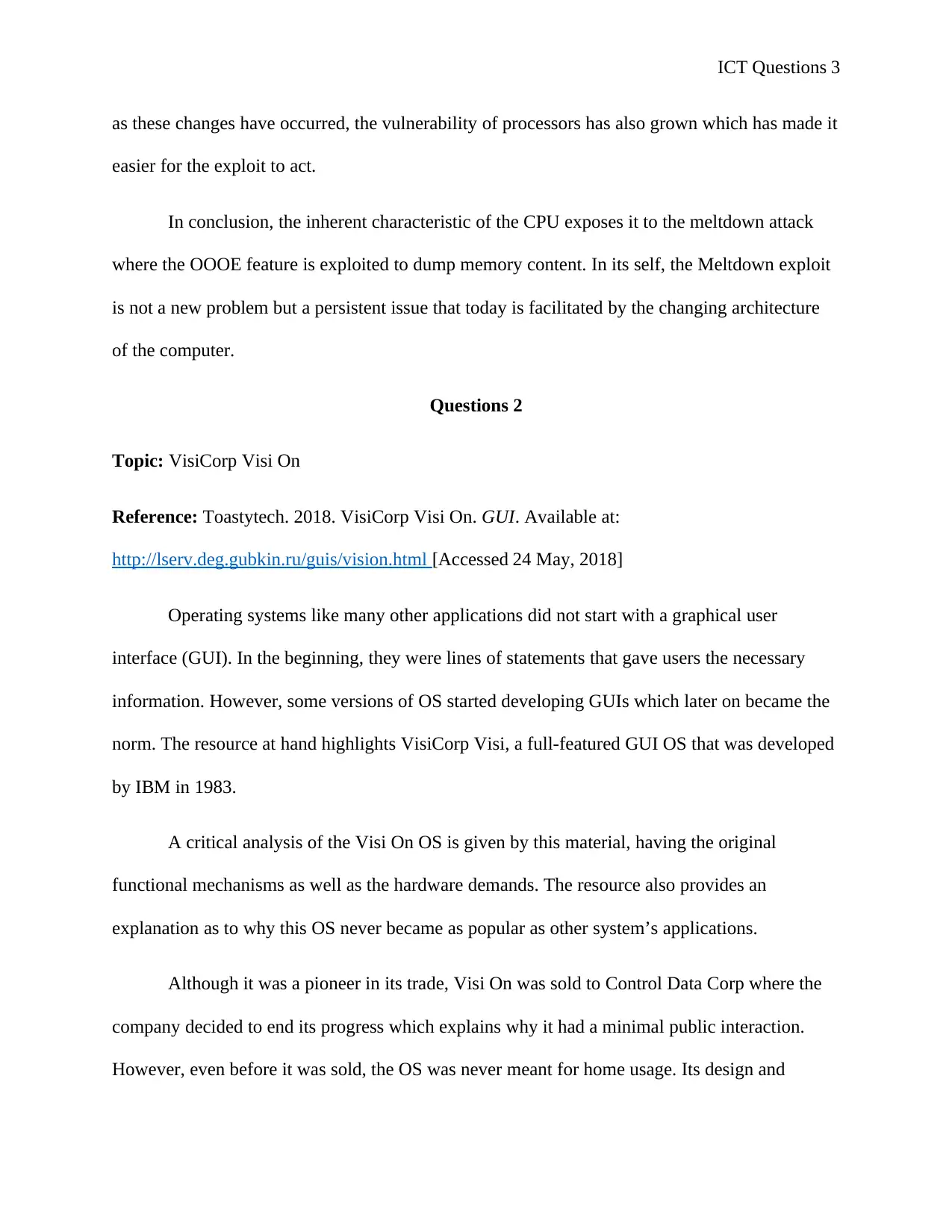
ICT Questions 3
as these changes have occurred, the vulnerability of processors has also grown which has made it
easier for the exploit to act.
In conclusion, the inherent characteristic of the CPU exposes it to the meltdown attack
where the OOOE feature is exploited to dump memory content. In its self, the Meltdown exploit
is not a new problem but a persistent issue that today is facilitated by the changing architecture
of the computer.
Questions 2
Topic: VisiCorp Visi On
Reference: Toastytech. 2018. VisiCorp Visi On. GUI. Available at:
http://lserv.deg.gubkin.ru/guis/vision.html [Accessed 24 May, 2018]
Operating systems like many other applications did not start with a graphical user
interface (GUI). In the beginning, they were lines of statements that gave users the necessary
information. However, some versions of OS started developing GUIs which later on became the
norm. The resource at hand highlights VisiCorp Visi, a full-featured GUI OS that was developed
by IBM in 1983.
A critical analysis of the Visi On OS is given by this material, having the original
functional mechanisms as well as the hardware demands. The resource also provides an
explanation as to why this OS never became as popular as other system’s applications.
Although it was a pioneer in its trade, Visi On was sold to Control Data Corp where the
company decided to end its progress which explains why it had a minimal public interaction.
However, even before it was sold, the OS was never meant for home usage. Its design and
as these changes have occurred, the vulnerability of processors has also grown which has made it
easier for the exploit to act.
In conclusion, the inherent characteristic of the CPU exposes it to the meltdown attack
where the OOOE feature is exploited to dump memory content. In its self, the Meltdown exploit
is not a new problem but a persistent issue that today is facilitated by the changing architecture
of the computer.
Questions 2
Topic: VisiCorp Visi On
Reference: Toastytech. 2018. VisiCorp Visi On. GUI. Available at:
http://lserv.deg.gubkin.ru/guis/vision.html [Accessed 24 May, 2018]
Operating systems like many other applications did not start with a graphical user
interface (GUI). In the beginning, they were lines of statements that gave users the necessary
information. However, some versions of OS started developing GUIs which later on became the
norm. The resource at hand highlights VisiCorp Visi, a full-featured GUI OS that was developed
by IBM in 1983.
A critical analysis of the Visi On OS is given by this material, having the original
functional mechanisms as well as the hardware demands. The resource also provides an
explanation as to why this OS never became as popular as other system’s applications.
Although it was a pioneer in its trade, Visi On was sold to Control Data Corp where the
company decided to end its progress which explains why it had a minimal public interaction.
However, even before it was sold, the OS was never meant for home usage. Its design and
⊘ This is a preview!⊘
Do you want full access?
Subscribe today to unlock all pages.

Trusted by 1+ million students worldwide
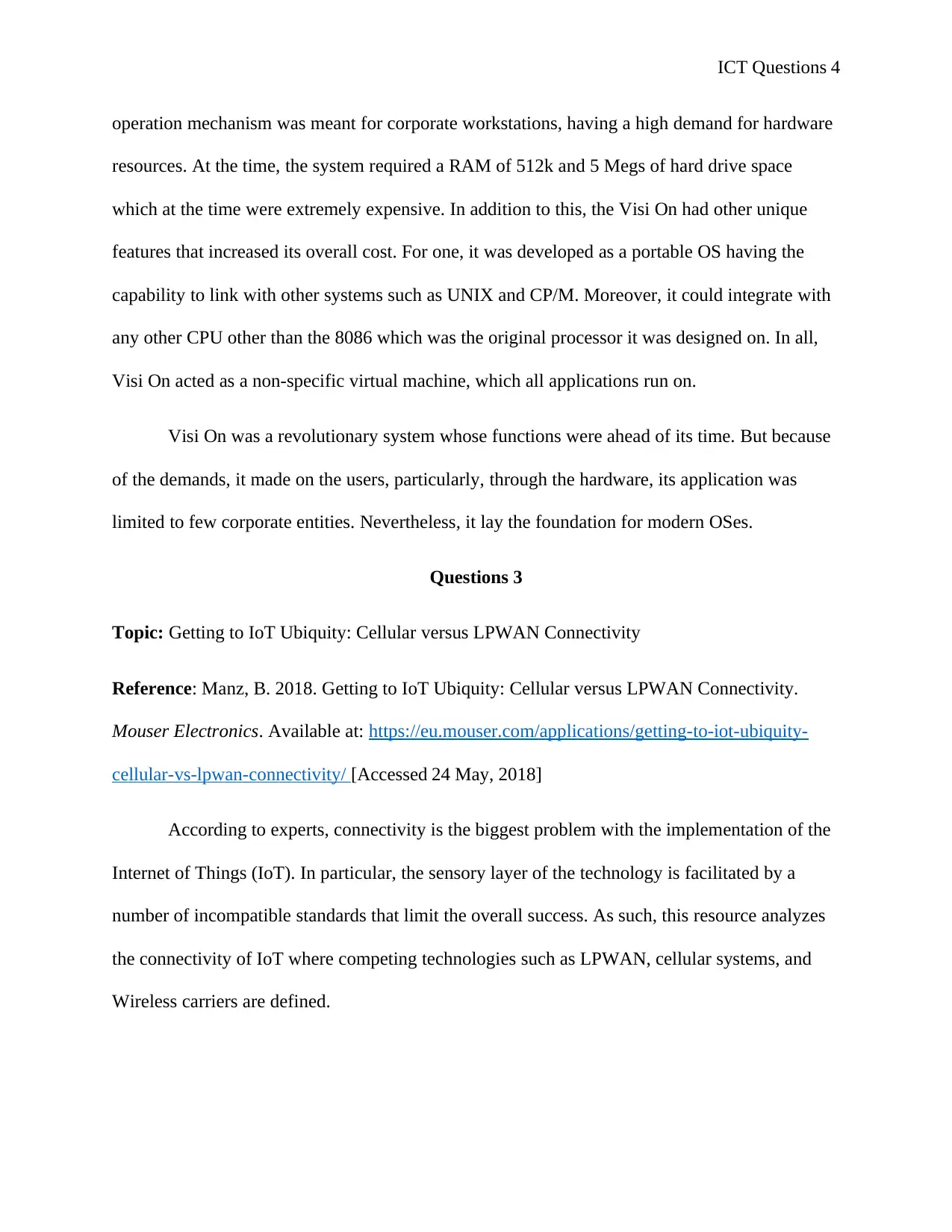
ICT Questions 4
operation mechanism was meant for corporate workstations, having a high demand for hardware
resources. At the time, the system required a RAM of 512k and 5 Megs of hard drive space
which at the time were extremely expensive. In addition to this, the Visi On had other unique
features that increased its overall cost. For one, it was developed as a portable OS having the
capability to link with other systems such as UNIX and CP/M. Moreover, it could integrate with
any other CPU other than the 8086 which was the original processor it was designed on. In all,
Visi On acted as a non-specific virtual machine, which all applications run on.
Visi On was a revolutionary system whose functions were ahead of its time. But because
of the demands, it made on the users, particularly, through the hardware, its application was
limited to few corporate entities. Nevertheless, it lay the foundation for modern OSes.
Questions 3
Topic: Getting to IoT Ubiquity: Cellular versus LPWAN Connectivity
Reference: Manz, B. 2018. Getting to IoT Ubiquity: Cellular versus LPWAN Connectivity.
Mouser Electronics. Available at: https://eu.mouser.com/applications/getting-to-iot-ubiquity-
cellular-vs-lpwan-connectivity/ [Accessed 24 May, 2018]
According to experts, connectivity is the biggest problem with the implementation of the
Internet of Things (IoT). In particular, the sensory layer of the technology is facilitated by a
number of incompatible standards that limit the overall success. As such, this resource analyzes
the connectivity of IoT where competing technologies such as LPWAN, cellular systems, and
Wireless carriers are defined.
operation mechanism was meant for corporate workstations, having a high demand for hardware
resources. At the time, the system required a RAM of 512k and 5 Megs of hard drive space
which at the time were extremely expensive. In addition to this, the Visi On had other unique
features that increased its overall cost. For one, it was developed as a portable OS having the
capability to link with other systems such as UNIX and CP/M. Moreover, it could integrate with
any other CPU other than the 8086 which was the original processor it was designed on. In all,
Visi On acted as a non-specific virtual machine, which all applications run on.
Visi On was a revolutionary system whose functions were ahead of its time. But because
of the demands, it made on the users, particularly, through the hardware, its application was
limited to few corporate entities. Nevertheless, it lay the foundation for modern OSes.
Questions 3
Topic: Getting to IoT Ubiquity: Cellular versus LPWAN Connectivity
Reference: Manz, B. 2018. Getting to IoT Ubiquity: Cellular versus LPWAN Connectivity.
Mouser Electronics. Available at: https://eu.mouser.com/applications/getting-to-iot-ubiquity-
cellular-vs-lpwan-connectivity/ [Accessed 24 May, 2018]
According to experts, connectivity is the biggest problem with the implementation of the
Internet of Things (IoT). In particular, the sensory layer of the technology is facilitated by a
number of incompatible standards that limit the overall success. As such, this resource analyzes
the connectivity of IoT where competing technologies such as LPWAN, cellular systems, and
Wireless carriers are defined.
Paraphrase This Document
Need a fresh take? Get an instant paraphrase of this document with our AI Paraphraser
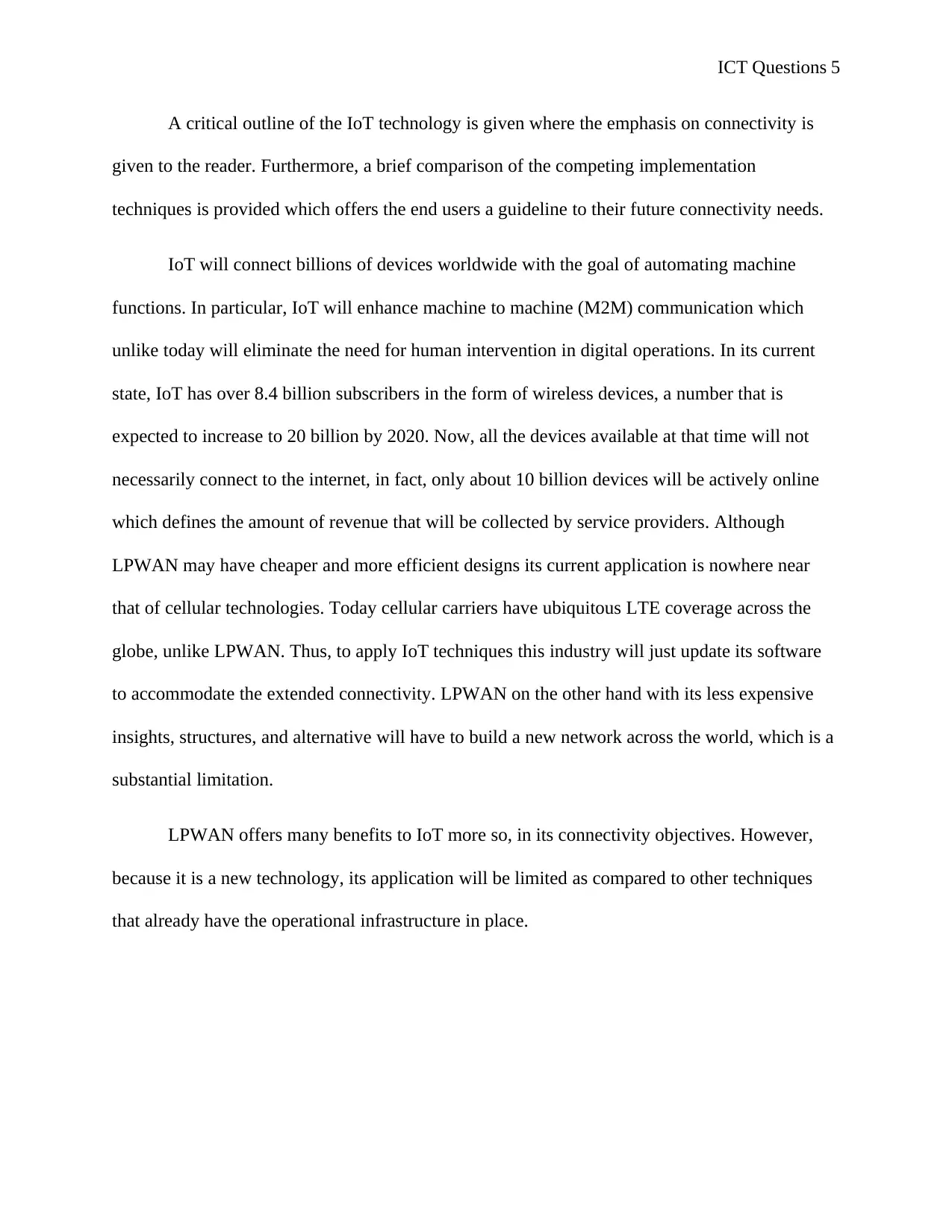
ICT Questions 5
A critical outline of the IoT technology is given where the emphasis on connectivity is
given to the reader. Furthermore, a brief comparison of the competing implementation
techniques is provided which offers the end users a guideline to their future connectivity needs.
IoT will connect billions of devices worldwide with the goal of automating machine
functions. In particular, IoT will enhance machine to machine (M2M) communication which
unlike today will eliminate the need for human intervention in digital operations. In its current
state, IoT has over 8.4 billion subscribers in the form of wireless devices, a number that is
expected to increase to 20 billion by 2020. Now, all the devices available at that time will not
necessarily connect to the internet, in fact, only about 10 billion devices will be actively online
which defines the amount of revenue that will be collected by service providers. Although
LPWAN may have cheaper and more efficient designs its current application is nowhere near
that of cellular technologies. Today cellular carriers have ubiquitous LTE coverage across the
globe, unlike LPWAN. Thus, to apply IoT techniques this industry will just update its software
to accommodate the extended connectivity. LPWAN on the other hand with its less expensive
insights, structures, and alternative will have to build a new network across the world, which is a
substantial limitation.
LPWAN offers many benefits to IoT more so, in its connectivity objectives. However,
because it is a new technology, its application will be limited as compared to other techniques
that already have the operational infrastructure in place.
A critical outline of the IoT technology is given where the emphasis on connectivity is
given to the reader. Furthermore, a brief comparison of the competing implementation
techniques is provided which offers the end users a guideline to their future connectivity needs.
IoT will connect billions of devices worldwide with the goal of automating machine
functions. In particular, IoT will enhance machine to machine (M2M) communication which
unlike today will eliminate the need for human intervention in digital operations. In its current
state, IoT has over 8.4 billion subscribers in the form of wireless devices, a number that is
expected to increase to 20 billion by 2020. Now, all the devices available at that time will not
necessarily connect to the internet, in fact, only about 10 billion devices will be actively online
which defines the amount of revenue that will be collected by service providers. Although
LPWAN may have cheaper and more efficient designs its current application is nowhere near
that of cellular technologies. Today cellular carriers have ubiquitous LTE coverage across the
globe, unlike LPWAN. Thus, to apply IoT techniques this industry will just update its software
to accommodate the extended connectivity. LPWAN on the other hand with its less expensive
insights, structures, and alternative will have to build a new network across the world, which is a
substantial limitation.
LPWAN offers many benefits to IoT more so, in its connectivity objectives. However,
because it is a new technology, its application will be limited as compared to other techniques
that already have the operational infrastructure in place.
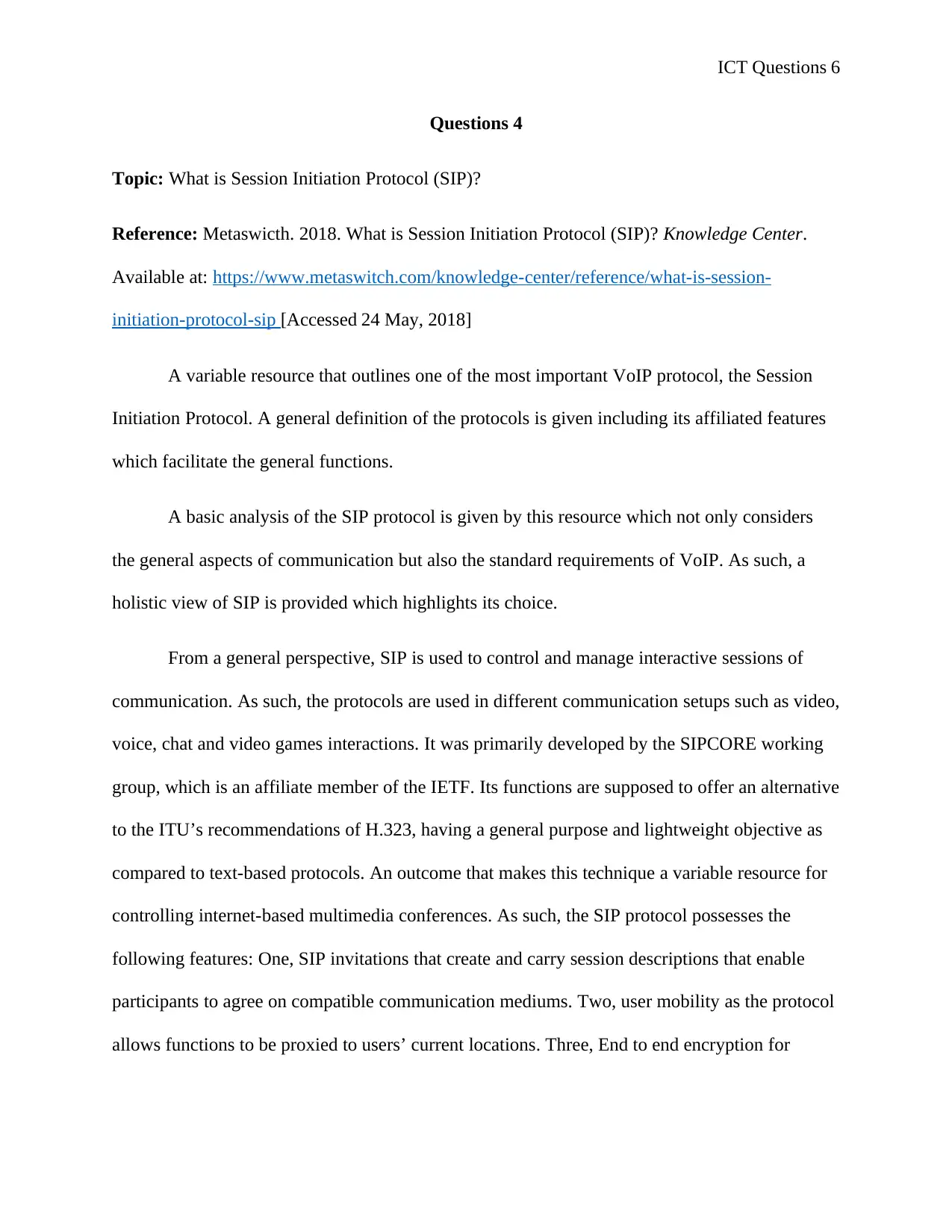
ICT Questions 6
Questions 4
Topic: What is Session Initiation Protocol (SIP)?
Reference: Metaswicth. 2018. What is Session Initiation Protocol (SIP)? Knowledge Center.
Available at: https://www.metaswitch.com/knowledge-center/reference/what-is-session-
initiation-protocol-sip [Accessed 24 May, 2018]
A variable resource that outlines one of the most important VoIP protocol, the Session
Initiation Protocol. A general definition of the protocols is given including its affiliated features
which facilitate the general functions.
A basic analysis of the SIP protocol is given by this resource which not only considers
the general aspects of communication but also the standard requirements of VoIP. As such, a
holistic view of SIP is provided which highlights its choice.
From a general perspective, SIP is used to control and manage interactive sessions of
communication. As such, the protocols are used in different communication setups such as video,
voice, chat and video games interactions. It was primarily developed by the SIPCORE working
group, which is an affiliate member of the IETF. Its functions are supposed to offer an alternative
to the ITU’s recommendations of H.323, having a general purpose and lightweight objective as
compared to text-based protocols. An outcome that makes this technique a variable resource for
controlling internet-based multimedia conferences. As such, the SIP protocol possesses the
following features: One, SIP invitations that create and carry session descriptions that enable
participants to agree on compatible communication mediums. Two, user mobility as the protocol
allows functions to be proxied to users’ current locations. Three, End to end encryption for
Questions 4
Topic: What is Session Initiation Protocol (SIP)?
Reference: Metaswicth. 2018. What is Session Initiation Protocol (SIP)? Knowledge Center.
Available at: https://www.metaswitch.com/knowledge-center/reference/what-is-session-
initiation-protocol-sip [Accessed 24 May, 2018]
A variable resource that outlines one of the most important VoIP protocol, the Session
Initiation Protocol. A general definition of the protocols is given including its affiliated features
which facilitate the general functions.
A basic analysis of the SIP protocol is given by this resource which not only considers
the general aspects of communication but also the standard requirements of VoIP. As such, a
holistic view of SIP is provided which highlights its choice.
From a general perspective, SIP is used to control and manage interactive sessions of
communication. As such, the protocols are used in different communication setups such as video,
voice, chat and video games interactions. It was primarily developed by the SIPCORE working
group, which is an affiliate member of the IETF. Its functions are supposed to offer an alternative
to the ITU’s recommendations of H.323, having a general purpose and lightweight objective as
compared to text-based protocols. An outcome that makes this technique a variable resource for
controlling internet-based multimedia conferences. As such, the SIP protocol possesses the
following features: One, SIP invitations that create and carry session descriptions that enable
participants to agree on compatible communication mediums. Two, user mobility as the protocol
allows functions to be proxied to users’ current locations. Three, End to end encryption for
⊘ This is a preview!⊘
Do you want full access?
Subscribe today to unlock all pages.

Trusted by 1+ million students worldwide
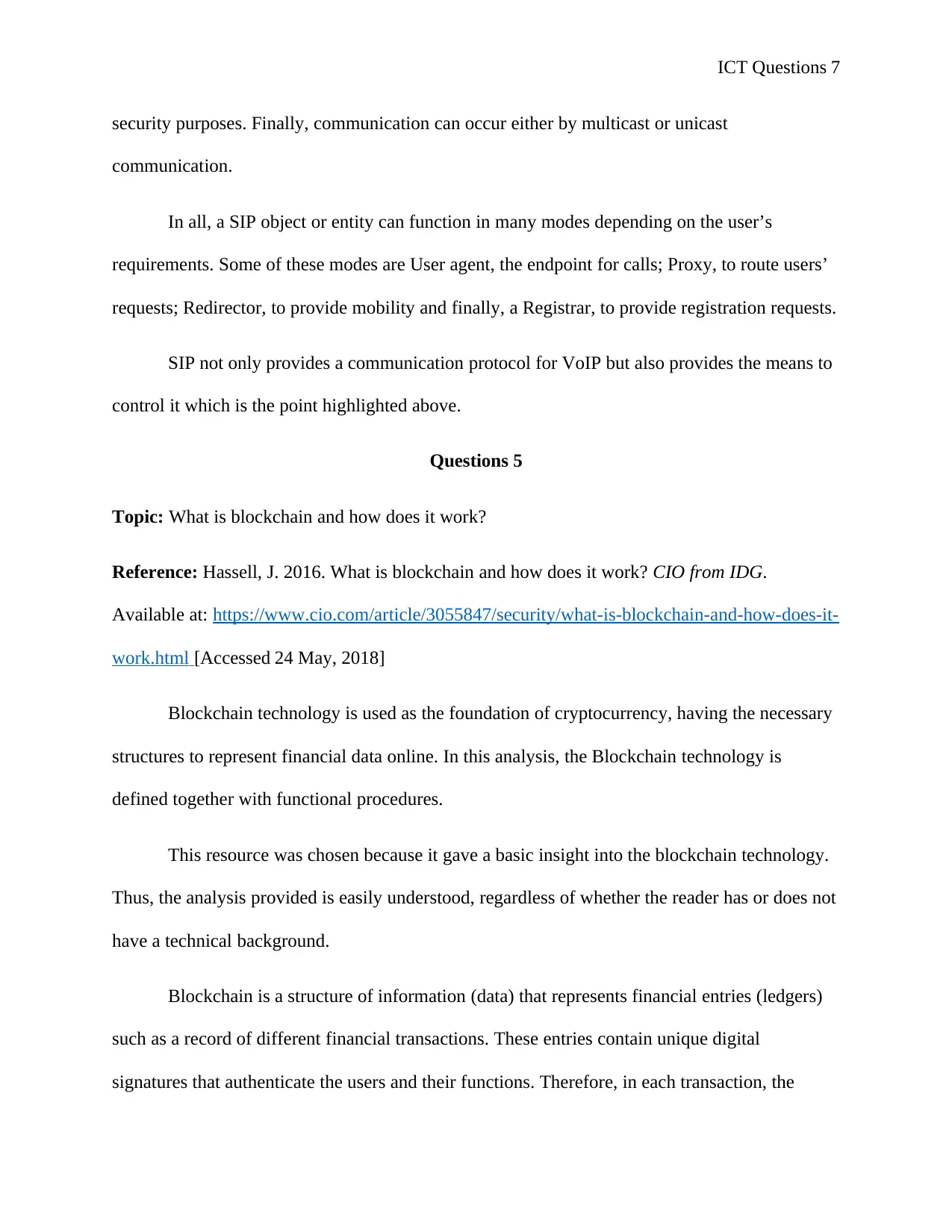
ICT Questions 7
security purposes. Finally, communication can occur either by multicast or unicast
communication.
In all, a SIP object or entity can function in many modes depending on the user’s
requirements. Some of these modes are User agent, the endpoint for calls; Proxy, to route users’
requests; Redirector, to provide mobility and finally, a Registrar, to provide registration requests.
SIP not only provides a communication protocol for VoIP but also provides the means to
control it which is the point highlighted above.
Questions 5
Topic: What is blockchain and how does it work?
Reference: Hassell, J. 2016. What is blockchain and how does it work? CIO from IDG.
Available at: https://www.cio.com/article/3055847/security/what-is-blockchain-and-how-does-it-
work.html [Accessed 24 May, 2018]
Blockchain technology is used as the foundation of cryptocurrency, having the necessary
structures to represent financial data online. In this analysis, the Blockchain technology is
defined together with functional procedures.
This resource was chosen because it gave a basic insight into the blockchain technology.
Thus, the analysis provided is easily understood, regardless of whether the reader has or does not
have a technical background.
Blockchain is a structure of information (data) that represents financial entries (ledgers)
such as a record of different financial transactions. These entries contain unique digital
signatures that authenticate the users and their functions. Therefore, in each transaction, the
security purposes. Finally, communication can occur either by multicast or unicast
communication.
In all, a SIP object or entity can function in many modes depending on the user’s
requirements. Some of these modes are User agent, the endpoint for calls; Proxy, to route users’
requests; Redirector, to provide mobility and finally, a Registrar, to provide registration requests.
SIP not only provides a communication protocol for VoIP but also provides the means to
control it which is the point highlighted above.
Questions 5
Topic: What is blockchain and how does it work?
Reference: Hassell, J. 2016. What is blockchain and how does it work? CIO from IDG.
Available at: https://www.cio.com/article/3055847/security/what-is-blockchain-and-how-does-it-
work.html [Accessed 24 May, 2018]
Blockchain technology is used as the foundation of cryptocurrency, having the necessary
structures to represent financial data online. In this analysis, the Blockchain technology is
defined together with functional procedures.
This resource was chosen because it gave a basic insight into the blockchain technology.
Thus, the analysis provided is easily understood, regardless of whether the reader has or does not
have a technical background.
Blockchain is a structure of information (data) that represents financial entries (ledgers)
such as a record of different financial transactions. These entries contain unique digital
signatures that authenticate the users and their functions. Therefore, in each transaction, the
Paraphrase This Document
Need a fresh take? Get an instant paraphrase of this document with our AI Paraphraser
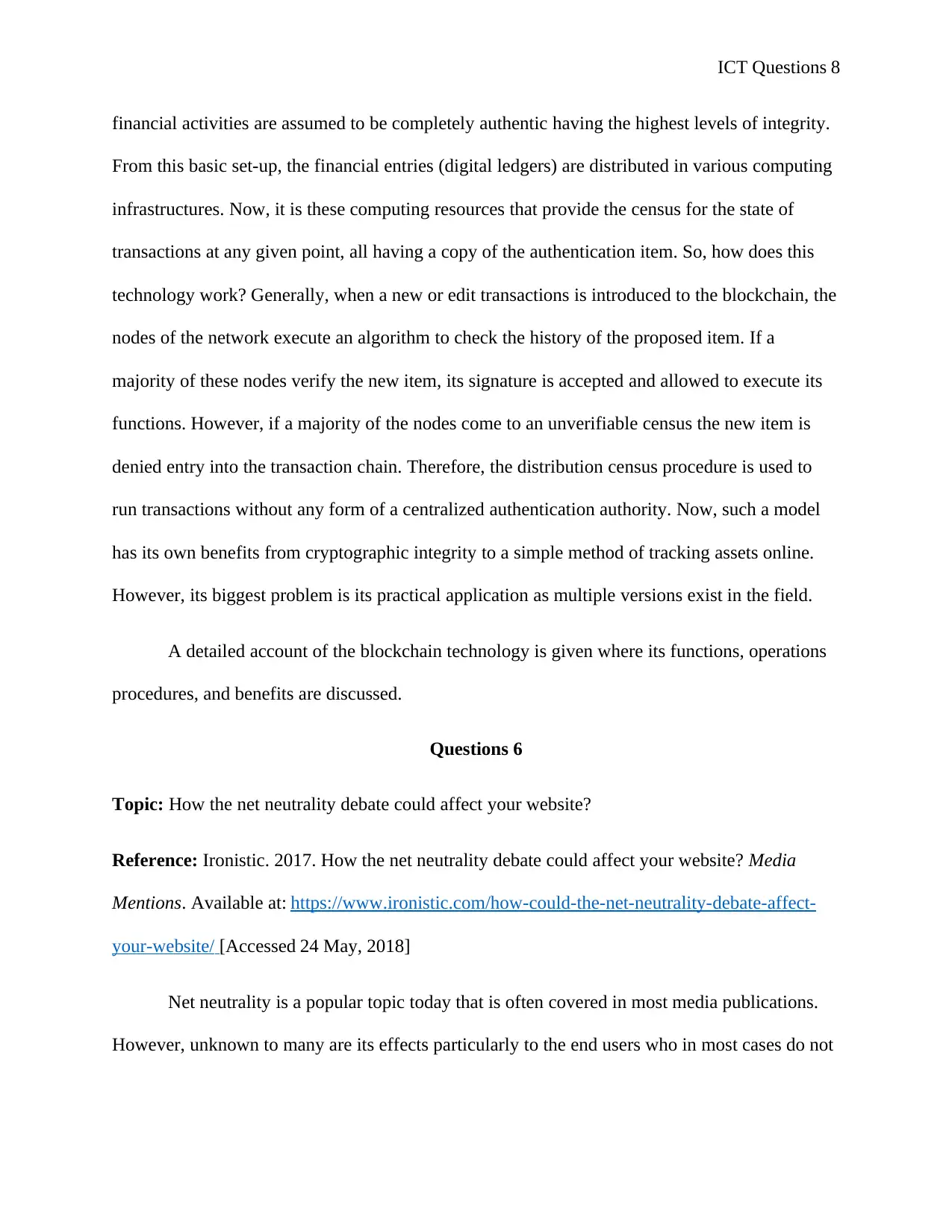
ICT Questions 8
financial activities are assumed to be completely authentic having the highest levels of integrity.
From this basic set-up, the financial entries (digital ledgers) are distributed in various computing
infrastructures. Now, it is these computing resources that provide the census for the state of
transactions at any given point, all having a copy of the authentication item. So, how does this
technology work? Generally, when a new or edit transactions is introduced to the blockchain, the
nodes of the network execute an algorithm to check the history of the proposed item. If a
majority of these nodes verify the new item, its signature is accepted and allowed to execute its
functions. However, if a majority of the nodes come to an unverifiable census the new item is
denied entry into the transaction chain. Therefore, the distribution census procedure is used to
run transactions without any form of a centralized authentication authority. Now, such a model
has its own benefits from cryptographic integrity to a simple method of tracking assets online.
However, its biggest problem is its practical application as multiple versions exist in the field.
A detailed account of the blockchain technology is given where its functions, operations
procedures, and benefits are discussed.
Questions 6
Topic: How the net neutrality debate could affect your website?
Reference: Ironistic. 2017. How the net neutrality debate could affect your website? Media
Mentions. Available at: https://www.ironistic.com/how-could-the-net-neutrality-debate-affect-
your-website/ [Accessed 24 May, 2018]
Net neutrality is a popular topic today that is often covered in most media publications.
However, unknown to many are its effects particularly to the end users who in most cases do not
financial activities are assumed to be completely authentic having the highest levels of integrity.
From this basic set-up, the financial entries (digital ledgers) are distributed in various computing
infrastructures. Now, it is these computing resources that provide the census for the state of
transactions at any given point, all having a copy of the authentication item. So, how does this
technology work? Generally, when a new or edit transactions is introduced to the blockchain, the
nodes of the network execute an algorithm to check the history of the proposed item. If a
majority of these nodes verify the new item, its signature is accepted and allowed to execute its
functions. However, if a majority of the nodes come to an unverifiable census the new item is
denied entry into the transaction chain. Therefore, the distribution census procedure is used to
run transactions without any form of a centralized authentication authority. Now, such a model
has its own benefits from cryptographic integrity to a simple method of tracking assets online.
However, its biggest problem is its practical application as multiple versions exist in the field.
A detailed account of the blockchain technology is given where its functions, operations
procedures, and benefits are discussed.
Questions 6
Topic: How the net neutrality debate could affect your website?
Reference: Ironistic. 2017. How the net neutrality debate could affect your website? Media
Mentions. Available at: https://www.ironistic.com/how-could-the-net-neutrality-debate-affect-
your-website/ [Accessed 24 May, 2018]
Net neutrality is a popular topic today that is often covered in most media publications.
However, unknown to many are its effects particularly to the end users who in most cases do not
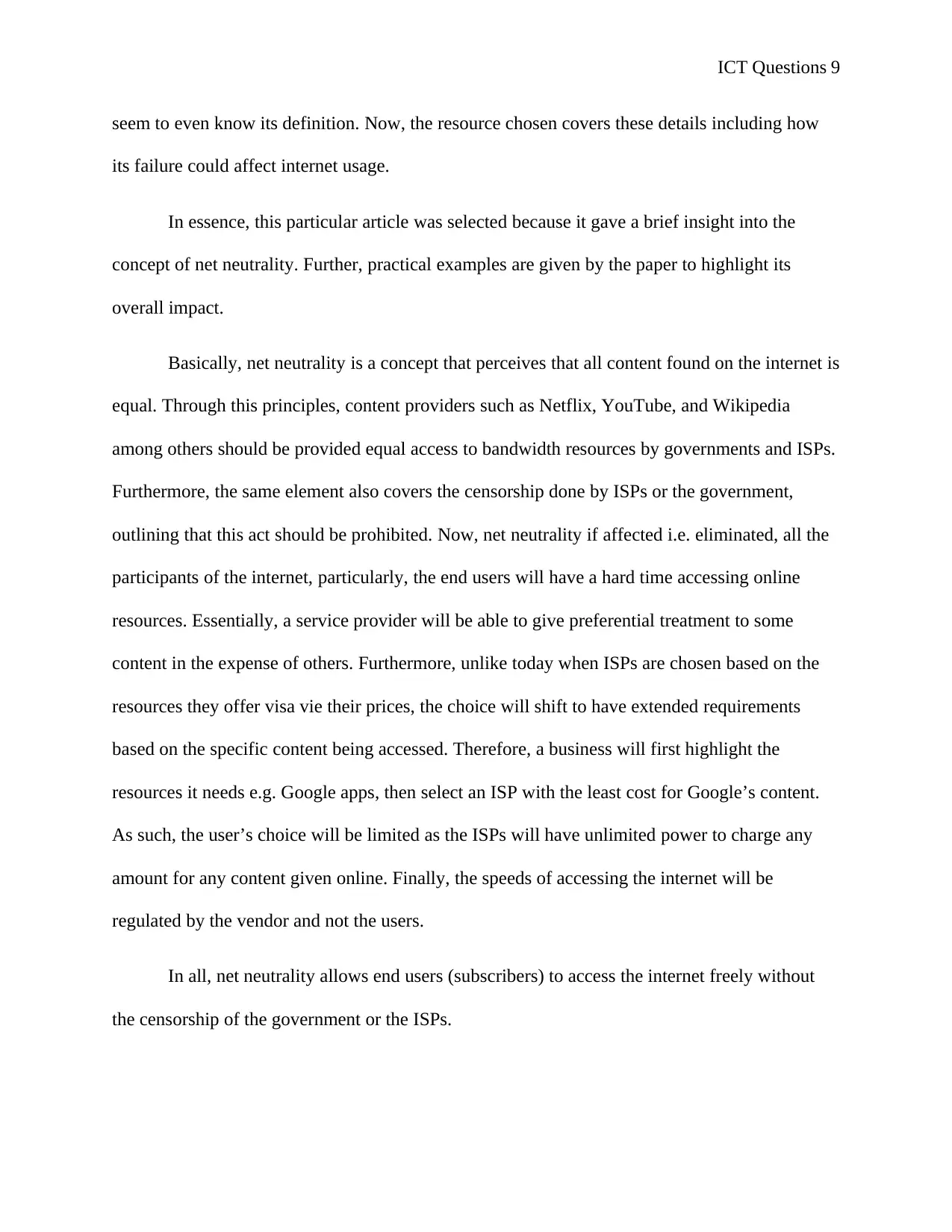
ICT Questions 9
seem to even know its definition. Now, the resource chosen covers these details including how
its failure could affect internet usage.
In essence, this particular article was selected because it gave a brief insight into the
concept of net neutrality. Further, practical examples are given by the paper to highlight its
overall impact.
Basically, net neutrality is a concept that perceives that all content found on the internet is
equal. Through this principles, content providers such as Netflix, YouTube, and Wikipedia
among others should be provided equal access to bandwidth resources by governments and ISPs.
Furthermore, the same element also covers the censorship done by ISPs or the government,
outlining that this act should be prohibited. Now, net neutrality if affected i.e. eliminated, all the
participants of the internet, particularly, the end users will have a hard time accessing online
resources. Essentially, a service provider will be able to give preferential treatment to some
content in the expense of others. Furthermore, unlike today when ISPs are chosen based on the
resources they offer visa vie their prices, the choice will shift to have extended requirements
based on the specific content being accessed. Therefore, a business will first highlight the
resources it needs e.g. Google apps, then select an ISP with the least cost for Google’s content.
As such, the user’s choice will be limited as the ISPs will have unlimited power to charge any
amount for any content given online. Finally, the speeds of accessing the internet will be
regulated by the vendor and not the users.
In all, net neutrality allows end users (subscribers) to access the internet freely without
the censorship of the government or the ISPs.
seem to even know its definition. Now, the resource chosen covers these details including how
its failure could affect internet usage.
In essence, this particular article was selected because it gave a brief insight into the
concept of net neutrality. Further, practical examples are given by the paper to highlight its
overall impact.
Basically, net neutrality is a concept that perceives that all content found on the internet is
equal. Through this principles, content providers such as Netflix, YouTube, and Wikipedia
among others should be provided equal access to bandwidth resources by governments and ISPs.
Furthermore, the same element also covers the censorship done by ISPs or the government,
outlining that this act should be prohibited. Now, net neutrality if affected i.e. eliminated, all the
participants of the internet, particularly, the end users will have a hard time accessing online
resources. Essentially, a service provider will be able to give preferential treatment to some
content in the expense of others. Furthermore, unlike today when ISPs are chosen based on the
resources they offer visa vie their prices, the choice will shift to have extended requirements
based on the specific content being accessed. Therefore, a business will first highlight the
resources it needs e.g. Google apps, then select an ISP with the least cost for Google’s content.
As such, the user’s choice will be limited as the ISPs will have unlimited power to charge any
amount for any content given online. Finally, the speeds of accessing the internet will be
regulated by the vendor and not the users.
In all, net neutrality allows end users (subscribers) to access the internet freely without
the censorship of the government or the ISPs.
⊘ This is a preview!⊘
Do you want full access?
Subscribe today to unlock all pages.

Trusted by 1+ million students worldwide
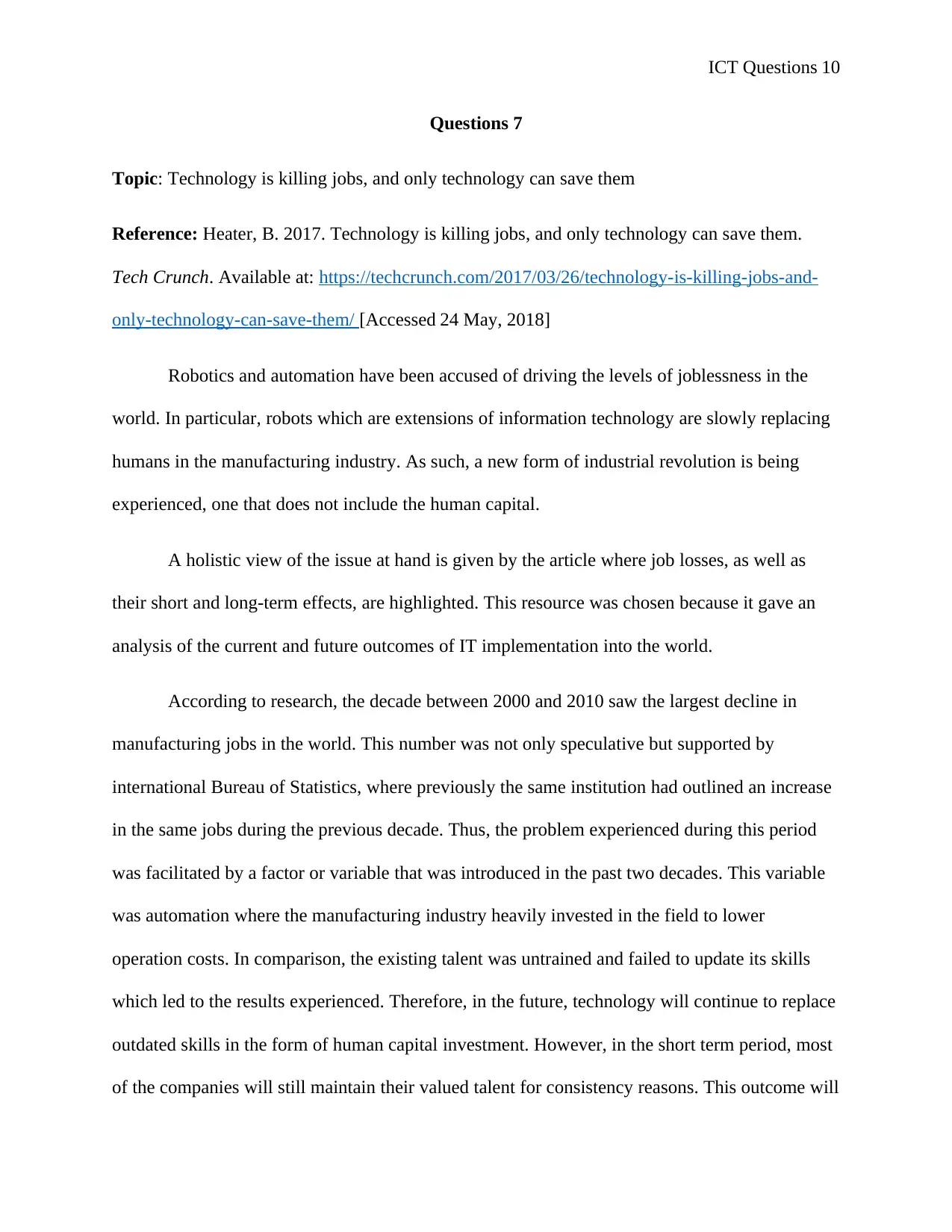
ICT Questions 10
Questions 7
Topic: Technology is killing jobs, and only technology can save them
Reference: Heater, B. 2017. Technology is killing jobs, and only technology can save them.
Tech Crunch. Available at: https://techcrunch.com/2017/03/26/technology-is-killing-jobs-and-
only-technology-can-save-them/ [Accessed 24 May, 2018]
Robotics and automation have been accused of driving the levels of joblessness in the
world. In particular, robots which are extensions of information technology are slowly replacing
humans in the manufacturing industry. As such, a new form of industrial revolution is being
experienced, one that does not include the human capital.
A holistic view of the issue at hand is given by the article where job losses, as well as
their short and long-term effects, are highlighted. This resource was chosen because it gave an
analysis of the current and future outcomes of IT implementation into the world.
According to research, the decade between 2000 and 2010 saw the largest decline in
manufacturing jobs in the world. This number was not only speculative but supported by
international Bureau of Statistics, where previously the same institution had outlined an increase
in the same jobs during the previous decade. Thus, the problem experienced during this period
was facilitated by a factor or variable that was introduced in the past two decades. This variable
was automation where the manufacturing industry heavily invested in the field to lower
operation costs. In comparison, the existing talent was untrained and failed to update its skills
which led to the results experienced. Therefore, in the future, technology will continue to replace
outdated skills in the form of human capital investment. However, in the short term period, most
of the companies will still maintain their valued talent for consistency reasons. This outcome will
Questions 7
Topic: Technology is killing jobs, and only technology can save them
Reference: Heater, B. 2017. Technology is killing jobs, and only technology can save them.
Tech Crunch. Available at: https://techcrunch.com/2017/03/26/technology-is-killing-jobs-and-
only-technology-can-save-them/ [Accessed 24 May, 2018]
Robotics and automation have been accused of driving the levels of joblessness in the
world. In particular, robots which are extensions of information technology are slowly replacing
humans in the manufacturing industry. As such, a new form of industrial revolution is being
experienced, one that does not include the human capital.
A holistic view of the issue at hand is given by the article where job losses, as well as
their short and long-term effects, are highlighted. This resource was chosen because it gave an
analysis of the current and future outcomes of IT implementation into the world.
According to research, the decade between 2000 and 2010 saw the largest decline in
manufacturing jobs in the world. This number was not only speculative but supported by
international Bureau of Statistics, where previously the same institution had outlined an increase
in the same jobs during the previous decade. Thus, the problem experienced during this period
was facilitated by a factor or variable that was introduced in the past two decades. This variable
was automation where the manufacturing industry heavily invested in the field to lower
operation costs. In comparison, the existing talent was untrained and failed to update its skills
which led to the results experienced. Therefore, in the future, technology will continue to replace
outdated skills in the form of human capital investment. However, in the short term period, most
of the companies will still maintain their valued talent for consistency reasons. This outcome will
Paraphrase This Document
Need a fresh take? Get an instant paraphrase of this document with our AI Paraphraser
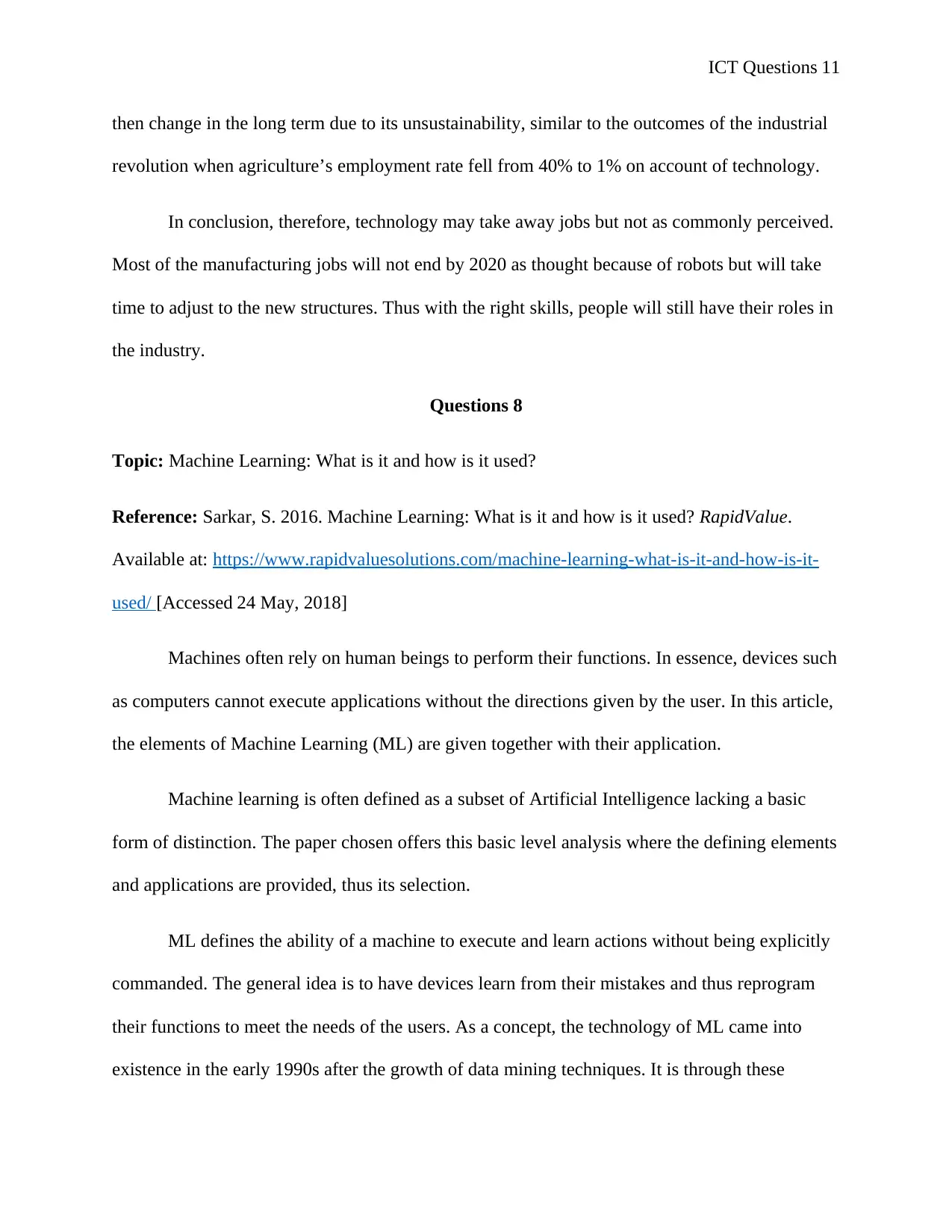
ICT Questions 11
then change in the long term due to its unsustainability, similar to the outcomes of the industrial
revolution when agriculture’s employment rate fell from 40% to 1% on account of technology.
In conclusion, therefore, technology may take away jobs but not as commonly perceived.
Most of the manufacturing jobs will not end by 2020 as thought because of robots but will take
time to adjust to the new structures. Thus with the right skills, people will still have their roles in
the industry.
Questions 8
Topic: Machine Learning: What is it and how is it used?
Reference: Sarkar, S. 2016. Machine Learning: What is it and how is it used? RapidValue.
Available at: https://www.rapidvaluesolutions.com/machine-learning-what-is-it-and-how-is-it-
used/ [Accessed 24 May, 2018]
Machines often rely on human beings to perform their functions. In essence, devices such
as computers cannot execute applications without the directions given by the user. In this article,
the elements of Machine Learning (ML) are given together with their application.
Machine learning is often defined as a subset of Artificial Intelligence lacking a basic
form of distinction. The paper chosen offers this basic level analysis where the defining elements
and applications are provided, thus its selection.
ML defines the ability of a machine to execute and learn actions without being explicitly
commanded. The general idea is to have devices learn from their mistakes and thus reprogram
their functions to meet the needs of the users. As a concept, the technology of ML came into
existence in the early 1990s after the growth of data mining techniques. It is through these
then change in the long term due to its unsustainability, similar to the outcomes of the industrial
revolution when agriculture’s employment rate fell from 40% to 1% on account of technology.
In conclusion, therefore, technology may take away jobs but not as commonly perceived.
Most of the manufacturing jobs will not end by 2020 as thought because of robots but will take
time to adjust to the new structures. Thus with the right skills, people will still have their roles in
the industry.
Questions 8
Topic: Machine Learning: What is it and how is it used?
Reference: Sarkar, S. 2016. Machine Learning: What is it and how is it used? RapidValue.
Available at: https://www.rapidvaluesolutions.com/machine-learning-what-is-it-and-how-is-it-
used/ [Accessed 24 May, 2018]
Machines often rely on human beings to perform their functions. In essence, devices such
as computers cannot execute applications without the directions given by the user. In this article,
the elements of Machine Learning (ML) are given together with their application.
Machine learning is often defined as a subset of Artificial Intelligence lacking a basic
form of distinction. The paper chosen offers this basic level analysis where the defining elements
and applications are provided, thus its selection.
ML defines the ability of a machine to execute and learn actions without being explicitly
commanded. The general idea is to have devices learn from their mistakes and thus reprogram
their functions to meet the needs of the users. As a concept, the technology of ML came into
existence in the early 1990s after the growth of data mining techniques. It is through these
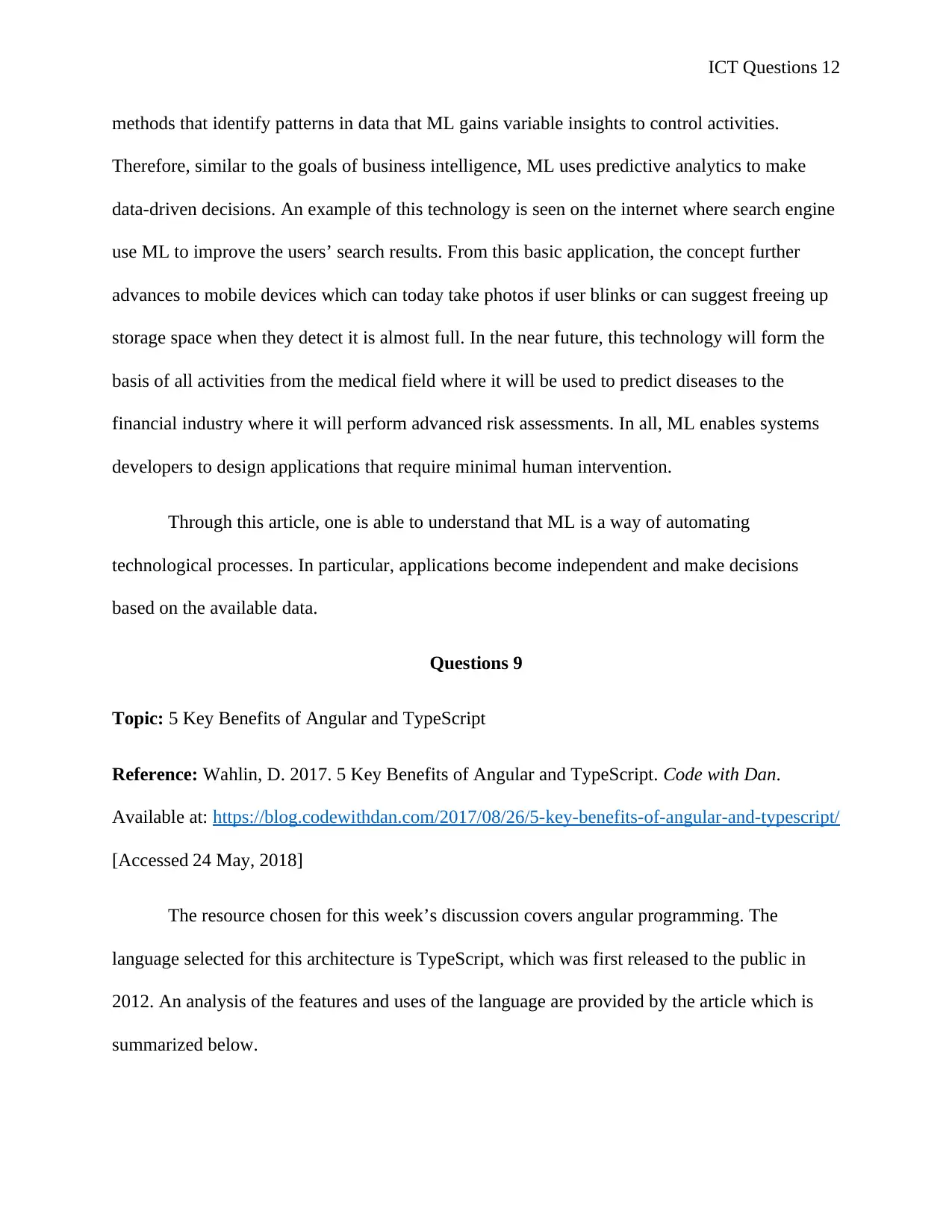
ICT Questions 12
methods that identify patterns in data that ML gains variable insights to control activities.
Therefore, similar to the goals of business intelligence, ML uses predictive analytics to make
data-driven decisions. An example of this technology is seen on the internet where search engine
use ML to improve the users’ search results. From this basic application, the concept further
advances to mobile devices which can today take photos if user blinks or can suggest freeing up
storage space when they detect it is almost full. In the near future, this technology will form the
basis of all activities from the medical field where it will be used to predict diseases to the
financial industry where it will perform advanced risk assessments. In all, ML enables systems
developers to design applications that require minimal human intervention.
Through this article, one is able to understand that ML is a way of automating
technological processes. In particular, applications become independent and make decisions
based on the available data.
Questions 9
Topic: 5 Key Benefits of Angular and TypeScript
Reference: Wahlin, D. 2017. 5 Key Benefits of Angular and TypeScript. Code with Dan.
Available at: https://blog.codewithdan.com/2017/08/26/5-key-benefits-of-angular-and-typescript/
[Accessed 24 May, 2018]
The resource chosen for this week’s discussion covers angular programming. The
language selected for this architecture is TypeScript, which was first released to the public in
2012. An analysis of the features and uses of the language are provided by the article which is
summarized below.
methods that identify patterns in data that ML gains variable insights to control activities.
Therefore, similar to the goals of business intelligence, ML uses predictive analytics to make
data-driven decisions. An example of this technology is seen on the internet where search engine
use ML to improve the users’ search results. From this basic application, the concept further
advances to mobile devices which can today take photos if user blinks or can suggest freeing up
storage space when they detect it is almost full. In the near future, this technology will form the
basis of all activities from the medical field where it will be used to predict diseases to the
financial industry where it will perform advanced risk assessments. In all, ML enables systems
developers to design applications that require minimal human intervention.
Through this article, one is able to understand that ML is a way of automating
technological processes. In particular, applications become independent and make decisions
based on the available data.
Questions 9
Topic: 5 Key Benefits of Angular and TypeScript
Reference: Wahlin, D. 2017. 5 Key Benefits of Angular and TypeScript. Code with Dan.
Available at: https://blog.codewithdan.com/2017/08/26/5-key-benefits-of-angular-and-typescript/
[Accessed 24 May, 2018]
The resource chosen for this week’s discussion covers angular programming. The
language selected for this architecture is TypeScript, which was first released to the public in
2012. An analysis of the features and uses of the language are provided by the article which is
summarized below.
⊘ This is a preview!⊘
Do you want full access?
Subscribe today to unlock all pages.

Trusted by 1+ million students worldwide
1 out of 15
Related Documents
Your All-in-One AI-Powered Toolkit for Academic Success.
+13062052269
info@desklib.com
Available 24*7 on WhatsApp / Email
![[object Object]](/_next/static/media/star-bottom.7253800d.svg)
Unlock your academic potential
Copyright © 2020–2025 A2Z Services. All Rights Reserved. Developed and managed by ZUCOL.



